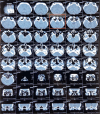Precise prediction of size of a foldable capsular vitreous body via computerized three-dimensional ocular reconstruction in severe retinal detachment
- PMID: 39304858
- PMCID: PMC11414271
- DOI: 10.1186/s12886-024-03646-9
Precise prediction of size of a foldable capsular vitreous body via computerized three-dimensional ocular reconstruction in severe retinal detachment
Abstract
Background: This study aimed to precisely predict the size and silicone oil injection of a foldable capsular vitreous body (FCVB) via computerized three-dimensional (3D) ocular reconstruction in the treatment of severe retinal detachment in China.
Methods: The 3D software Unigraphics NX was applied to determine the volume of the inner cavity with 16-30 mm axial length, assigning the anterior and posterior chambers, the FCVB sizes, and the silicone oil injection volume, and modeling the data between the axial length and the FCVB size. In clinical practice, IOL Master was applied to accurately measure the axial length of the contralateral healthy eye to anchor the anterior-posterior and horizontal diameters of the operated eye in horizontal position CT, and compared with the model to recommend the FCVB size and silicone oil amount, and the clinical effect was validated in cases across five hospitals in China.
Results: For the axial length of 16-30 mm, the volume of the inner cavity is 1.2 ml-8.4 ml. FCVB size and silicone oil volume were recommended based on this volume of the inner cavity. Of 253 cases, we noted 11 cases implanted with AV-10P and 1.05 ± 0.21 ml of silicone oil, 41 with AV-12P and 1.58 ± 0.18 ml of silicone oil, 163 with AV-13.5P and 2.48 ± 0.29 ml of silicone oil, 31 with AV-15P and 3.57 ± 0.39 ml of silicone oil, and 7 with AV-17P and 5.71 ± 0.81 ml of silicone oil. There was no significant difference in postoperative visual acuity scores compared with preoperative (P = 0.097), postoperative IOP(10.29 ± 0.57mmHg)was slightly higher than preoperative IOP (9.76 ± 0.48 mmHg), but there was still no statistically significant difference between the two comparisons (P = 0.405).
Conclusion: Three-dimensional reconstruction prediction is a good solution for eyeballs with obvious individualized changes in severe retinal detachment, and this method helps doctors standardize FCVB size selection and the silicone oil amount for patients.
Keywords: 3D reconstruction; FCVB; Retinal detachment; Silicone oil.
© 2024. The Author(s).
Conflict of interest statement
None of the authors has any conflicts of interest to disclose except for authors of Vesber Vitreous Institute. Vesber Vitreous Institute is a research center established by Guangzhou Vesber Biotechnology Co. Ltd. The institute mainly focuses on the research and translation of clinical medical results in ophthalmology, and the authors Qianying Gao, Siqi Qiao, Yingyu Wang and Yuanyuan Liu are all workers from the institute. The authors have no competing interests as defined by BMC, or other interests that might be perceived to influence the results and/or discussion reported in this paper.
Figures





Similar articles
-
The efficacy of intraoperative OCT combined with foldable artificial vitreous balloon (FCVB) implantation in eyes with complex retinal detachment and silicone oil dependence.BMC Ophthalmol. 2025 Jul 31;25(1):441. doi: 10.1186/s12886-025-04197-3. BMC Ophthalmol. 2025. PMID: 40745282 Free PMC article.
-
Preliminary efficacy and safety of a silicone oil-filled foldable capsular vitreous body in the treatment of severe retinal detachment.Retina. 2012 Apr;32(4):729-41. doi: 10.1097/IAE.0b013e31822b1f80. Retina. 2012. PMID: 22105508
-
Efficacy of Foldable Capsular Vitreous Body Implants Filled With Light or Heavy Silicone Oil in the Treatment of Silicone Oil-dependent Eyes.Transl Vis Sci Technol. 2024 Sep 3;13(9):2. doi: 10.1167/tvst.13.9.2. Transl Vis Sci Technol. 2024. PMID: 39226065 Free PMC article.
-
SILICONE OIL-FILLED FOLDABLE CAPSULAR VITREOUS BODY VERSUS SILICONE OIL ENDOTAMPONADE FOR TREATMENT OF NO LIGHT PERCEPTION AFTER SEVERE OCULAR TRAUMA.Retina. 2022 Mar 1;42(3):553-560. doi: 10.1097/IAE.0000000000003336. Retina. 2022. PMID: 35188493 Free PMC article.
-
Foldable capsular vitreous body indications, complications, and outcomes: a systematic review.Graefes Arch Clin Exp Ophthalmol. 2023 Aug;261(8):2103-2116. doi: 10.1007/s00417-023-05995-5. Epub 2023 Feb 16. Graefes Arch Clin Exp Ophthalmol. 2023. PMID: 36795160
Cited by
-
Consensus on the Treatment of Severe Ocular Trauma and Silicone Oil-Dependent Eyes Using Foldable Capsular Vitreous Body.J Evid Based Med. 2025 Jun;18(2):e70041. doi: 10.1111/jebm.70041. J Evid Based Med. 2025. PMID: 40571677 Free PMC article.
References
-
- Cibis PA, Becker B, Okun E, Canaan S. The use of liquid silicone in retinal detachment surgery. Arch Ophthalmol. 1962;68:590–9. - PubMed
-
- Hotta K, Sugitani A. Refractive changes in silicone oil-filled pseudophakic eyes. Retina. 2005;25(2):167–70. - PubMed
-
- Yeo JH, Glaser BM, Michels RG. Silicone oil in the treatment of complicated retinal detachments. Ophthalmology. 1987;94(9):1109–13. - PubMed
-
- Kobuch K, Menz IH, Hoerauf H, Dresp JH, Gabel VP. New substances for intraocular tamponades: perfluorocarbon liquids, hydrofluorocarbon liquids and hydrofluorocarbon-oligomers in vitreoretinal surgery. Graefes Arch Clin Exp Ophthalmol. 2001;239(9):635–42. - PubMed
MeSH terms
Substances
LinkOut - more resources
Full Text Sources
Medical

